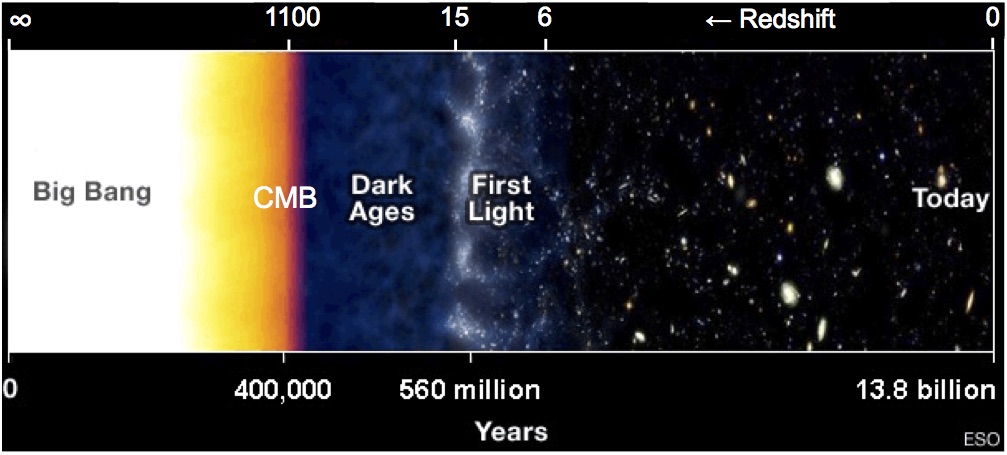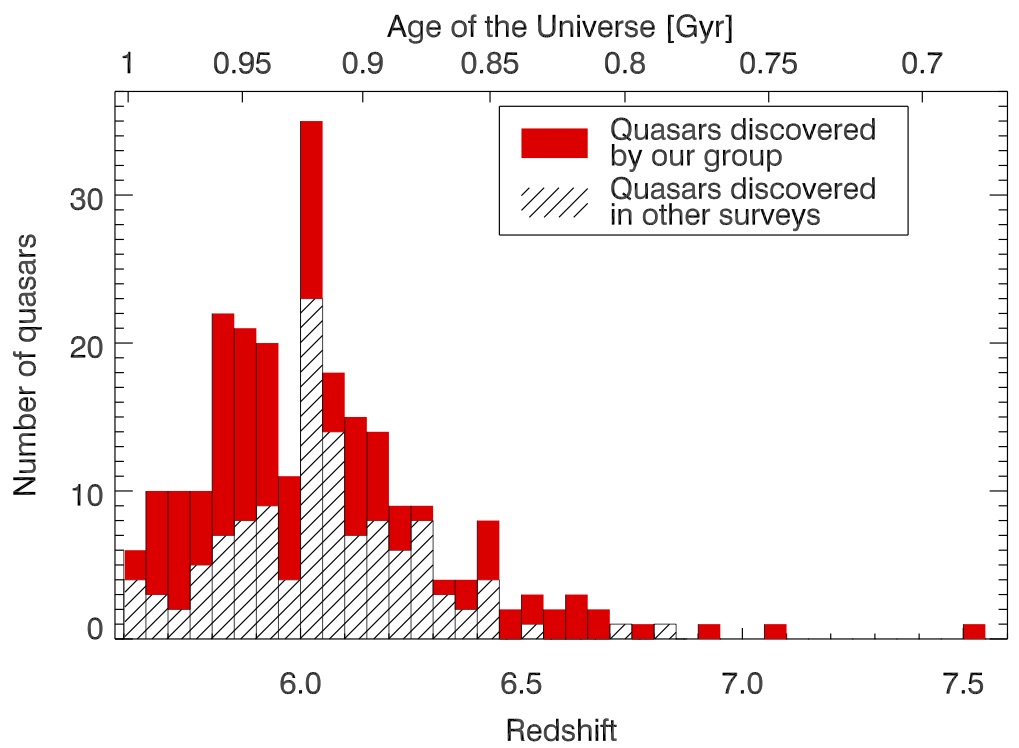|
|
|
|
|
Research
|
|
|
|
|
One of the main challenges in observational astronomy is to understand
how the first luminous objects in the Universe formed and evolved
through cosmic time. The earliest observable structure in the Universe
is the Cosmic Microwave Background (CMB), which dates back to the
epoch of recombination at a redshift of 𝓏≈1100, about
400,000 years after the Big Bang. The next most distant observable
represents the population of galaxies and quasars at
𝓏≈6−12, when the Universe was less than a billion years
old (see Figure 1). The interval between 𝓏∼1100 and
𝓏=6 contains many landmark events, such as the formation of
the first stars, the assembly of the first galaxies, the growth of the
first massive black holes and the reionisation of neutral Hydrogen in
the intergalactic medium. The most recent measurements of the CMB from
the Planck satellite indicate that reionisation occurred at
𝓏∼8 (600 million years after the Big Bang) but do not pin down
when reionisation began or ended.
My research aims to help
provide answers to outstanding questions in observational
cosmology, such as: when, how and over what period
was the Universe reionised? When did the first galaxies form and what
were the properties of these first objects? Where and how did the
earliest supermassive black holes form? Below I will describe my research in more detail: the search for the most distant quasars
|
|

Figure 1: Schematic history of the Universe with age on the bottom axis and redshift at the top. I am studying the ‘First Light’ period of the Universe.
Image credit: ESO.
|
|
|
|
Back to top
Distant quasars: probes of the early Universe
|
|
Quasars, powered by accretion onto supermassive, billion solar mass
black holes, are the most luminous, non-transient sources known and
hence have been found out to 𝓏>7. The high luminosity makes
quasars the only sources in the early Universe whose physical
properties can be studied in detail with current facilities and are
therefore crucial to our understanding of this transformational epoch
in the history of the Universe.
However, such luminous
accreting black holes are rare, with an estimated density of 1
Gpc3, in other words at the largest
distances there is only one accreting black hole per >100
deg2 on the sky. As a result, luminous
quasars are not found in the deep, pencil beam observations with,
e.g., the Hubble Space Telescope. Indeed, surveys covering a much
larger area of the sky are needed to uncover a large number of
quasars. About two decades ago, various optical surveys such as the
Sloan Digital Sky Survey discovered the first luminous quasars at
𝓏~6, less than 1 Gyr after the Big Bang (Figure 2). These
surveys could find quasars up to a redshift of 6.4. Beyond
𝓏=6.4, quasars become extremely faint in the optical and
near-infrared photometry is required to locate these distant
objects.
|
|
Figure 2: Redshift distribution of all 𝓏>5.6 quasars
known to date. Over the last 15 years, various groups discovered
~120 quasars (hashed histogram). In the last few years, our
group has discovered an additional 125 quasars in various
optical and near-infrared surveys (red histogram, see, for
example, Bañados, Venemans et al. 2014, 2015, 2016, 2017;
Mazzucchelli et al. 2017; Venemans et al. 2013, 2015a, 2015b) ,
more than doubling the number of quasars at
𝓏>5.6. Especially at the highest redshifts, 𝓏>6.5,
these projects provided a breakthrough in the field of distant
quasars, including the discovery of the most distant quasar at
𝓏=7.5 (Bañados, Venemans et al. 2017). |

|
|
|
|
Over the last 10 years, with the advent of wide field, near-infrared
cameras, large near-infrared surveys started to image the sky to
sufficient depth to uncover distant quasars. Our group at MPIA, led by
Fabian Walter and me, has successfully been searching for the earliest
quasars in these new surveys. The surveys include the Pan-STARRS1
survey (covering 3/4 of the sky in 5 filters up to 1 micron) and the
VISTA Kilo-Degree Infrared Galaxy (VIKING) survey. The efforts
resulted in a doubling of the number of quasars known at 𝓏~6
(see, for example, Bañados, Venemans et al. 2016) and pushed the
redshift barrier to 𝓏~7.5 (e.g., Venemans et al. 2013;
Bañados, Venemans et al. 2017, see Figure 2).
| |
 |
 |
|
|
|
|
|
|
|